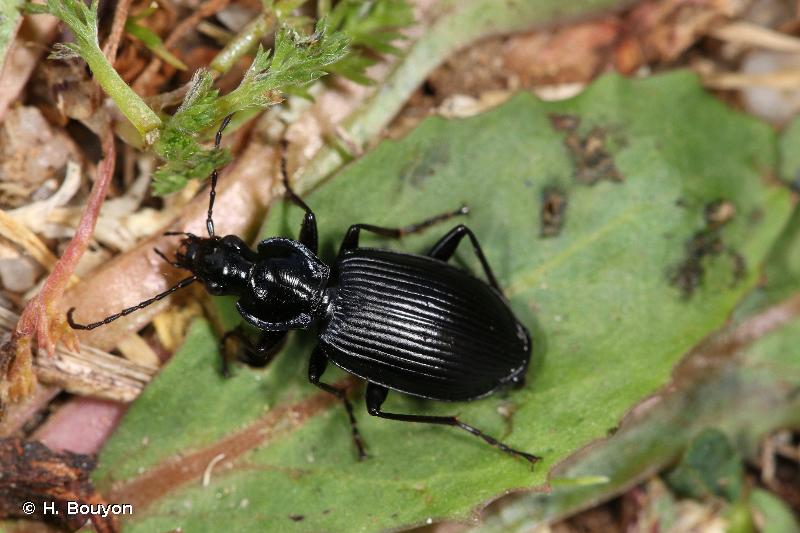
cd_nom

| Author : Magellanes |
 |
To get the picture, please visit:
Any reuse of one or more photographs on this site is subject to an authorization request from the author.
Link to the Code of Intellectual Property (Legifrance)

| Author : H. Bouyon |
 |
To get the picture, please visit:
Hervé BOUYON
email : herve.bouyon@wanadoo.fr
Any reuse of one or more photographs on this site is subject to an authorization request from the author.
Link to the Code of Intellectual Property (Legifrance)
Taille : 11-14 mm
Diagnose : Entièrement noir luisant, les pattes parfois brunâtres ; pronotum plan, la gouttière marginale élargie en arrière, sinuosité basale faible, les angles postérieurs vifs ; élytres à épaules saillantes, peu élargis en arrière, les stries profondes, les interstries convexes.
Identification : Sous binoculaire pour vérifier que le corps est entièrement glabre, la soie pronotale postérieure présente, la gouttière marginale du pronotum très large, la sinuosité basale faible et ses angles postérieurs bien marqués.
Confusions possibles : Avec les espèces du sous-genre Batenus ; ces dernières ont les angles postérieurs du Pronotum obtus ou arrondis (au moins en France) ; confusion possible également avec Platynus assimilis mais la forme du pronotum est bien différente également. Ces espèces ne sont pas présentes en Corse.
Périodes d'observation de l'adulte : L'adulte est actif dès le printemps et en été.
Biogéographie-écologie : L'espèce est présente à basse altitude en milieux humides.
Références :COULON J., PUPIER R., QUEINNEC E., OLLIVIER E. & RICHOUX P., 2011.- Coléoptères Carabiques. Compléments et mise à jour. Volume 2, Faune de France 95, Fédération Française des Sociétés de Sciences Naturelles, Paris : 371 – 684.
HURKA K., 1996.- Carabidae of the Czech and Slovak Republics. Editor : V. Kabourek, Zlin : 1 – 565.
JEANNEL R., 1942.- Coléoptères Carabiques, deuxième partie. Faune de France 40, Fédération Française des Sociétés de Sciences Naturelles, Paris : 573-1173.
Patrice Machard(),2019
Continental
Metropolitan France
Overseas
Marine
Metropolitan France
Overseas
The map presents a summary at the 10 x 10 km grid of the observation data for the species transmitted to the SINP. These data have been subjected to validation filters.
The map presents a reference distribution layer of the species at the scale of departments and marine sectors. The presence and absence data were established by expertise within a network of partners. This reference distribution is used in the validation process of the SINP data at the INPN level.
Corresponds to a report on the basis of at least one observation proved within a period of 10 years (20 years for little-known invertebrates) preceding the year and no presumption of extinction since obtaining the last data nor doubt on reproductive and implemented nature of this population. For migratory species, the presence indicated concerns areas of reproduction.
This status is based on one or more of the following criteria:
This point covers the absence, more difficult by nature to demonstrate than presence. This status is based on one or more of the following criteria:
This status must be assigned to a department in which the presence of the species is casual.
Particular case of absence due to a proven extinction less than a half century ago (older disappearances are treated as "no probable or definite").
In the state of knowledge, we can not comment on the presence or absence in the current department. This is the default status when not comprised in one of the previous categories or whenever there is doubt.
The map shows the global distribution of the species based on GBIF data (Global Biodiversity Information Facility).
